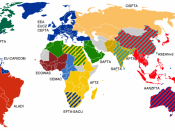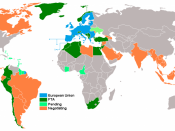1. INTRODUCTION
1.1. Background
On 8 February, after almost 12 months of negotiations, Australia's Trade Minister and the United States Trade Representative announced that agreement has been reached on the main body of the text for the Australia-United States Free Trade Agreement (AUSFTA). Although yet to pass through the Australian and US domestic legislative processes that bring the 'agreed text' into effect, the agreement allows for removal of almost all tariffs on manufactured goods, substantial reductions in tariffs on agricultural goods, removal of discrimination in government procurement, enhanced intellectual property protection and improved access for services. It will allow for substantial integration of the US and Australian economies and, according to the US Trade Representative, is 'the most significant cut in industrial tariffs ever achieved in a US free trade agreement'. However, many of the associated annexes to the text are yet to be agreed. The Agreement is not likely to come into force before 1 January 2005.
Australia's first Free Trade Agreement (FTA) was concluded with New Zealand (ANZCER) - more than 20 years ago, with this "Closer Economic Relationship" delivering economic benefits to both countries. Then two FTAs have been concluded with Asian trading partners in 2003, namely Singapore (July) and Thailand (October). So how is the current trading relationship between Australia and US? According to Rawson (2003), Director of Safety, Health and Trade Policy in Minerals Council of Australia, key aspects are showed as the following:
the US is Australia's largest trading partner with a two way trade of A$44 billion accounting for 15% of total trade
the US is Australia's key export market - the second largest behind Japan
o the US is the single most important market for services and elaborately transformed manufactures (ETMs)
o the US market has the highest growth rate (a 5...



For the format
I'm a new guy here. This essay was in Microsoft Word format. I don'n know why there are such disordered codes. Really sorry for that.
1 out of 1 people found this comment useful.